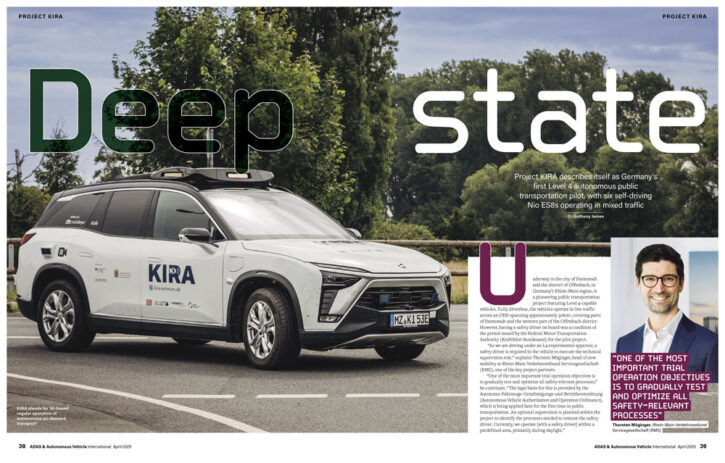Deutsche Bahn (DB) and Rhein-Main-Verkehrsverbund (RMV) are leading the initiative, which claims to be the first project in Germany to test Level 4 autonomous vehicles with passengers in public transportation.
The six vehicles operate in the service areas of regional project partners HEAG mobilo and Kreisverkehrsgesellschaft Offenbach (kvgOF). They travel in live road traffic, with the vehicles making all driving decisions. A safety driver will always be on board during the project’s testing phase. The vehicles’ maneuvers are also monitored by technical supervisory personnel in a control center.
DB Regio Bus Mitte operates the autonomous vehicles. The DB company Ioki provides the software for booking and route planning, integrating software components from various technology partners. Mobileye, another partner, supplies the self-driving technology, HD maps and specialized sensors.
Autonomous on-demand services have the potential to make public transportation more flexible and accessible. The shuttles are ordered as needed (on-demand), providing improved mobility, particularly in suburban and rural areas. On-demand shuttles with drivers are already operating in 10 RMV areas. Autonomous services, operating without onboard personnel, are ideal for deployment during off-peak hours and in more sparsely populated regions. The intelligent linking of various modes of transportation aims to enable seamless door-to-door mobility that is as flexible as owning a private car.
The test operation is initially scheduled until the end of 2025, with a planned extension. The groundbreaking pilot and research project benefits from financial support totaling approximately €2.2m (US$2.5m) from the Federal Ministry for Transport (BMV) and the State of Hesse. Research partners in the project include the German Aerospace Center (DLR), the Karlsruhe Institute of Technology (KIT) and the Association of German Transport Companies (VDV).
“Autonomous driving is a pivotal key technology for innovative, environmentally friendly and accessible mobility,” said Patrick Schnieder, Federal Minister for Transport. “Our long-term goal is for it to become standard operation across Germany. Through our funding of the KIRA project, we want to inspire local citizens about this technology. They can simply and conveniently be picked up and taken to their destination by autonomous shuttles. This makes autonomous driving tangible and demonstrates how this form of mobility can enhance people’s quality of life in the region.”
“In the future, autonomous driving can enable public transport to be offered anytime, anywhere,” added Prof. Knut Ringat, CEO of Rhein-Main-Verkehrsverbund. “Rural regions, in particular, will benefit from this. When driverless, flexibly bookable minibuses operate 24/7 where today scheduled buses only run a handful of times a day, public transport becomes available to everyone and significantly more attractive. With the lighthouse project KIRA, we are leading the way and are deploying autonomous vehicles with passengers in regular road traffic for the first time in Germany. We are paving the way to complement and expand public transport services, especially in rural areas, with autonomous on-demand shuttles by the 2030s.”
You can read an exclusive feature on Project KIRA in the April 2025 issue of ADAS & Autonomous Vehicle International.



